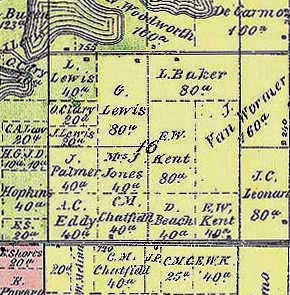The
Highland Township Historical Society |
|---|
Why Are There No Parcel Descriptions For Land In Section 16?
The Land Ordinance of 1785 reserved Section 16 of each township for educational uses. After Michigan was admitted to the union in 1837, control (although not ownership) of Section 16 lands was transferred to the state. Within months the state legislature enacted a law authorizing the sale of all Section 16 lands at auction, with the proceeds to be invested and any income used for educational purposes. The minimum bid was set at $8.00 per acre, with one-fourth due immediately and the balance payable over time at 7 percent interest. At first sales were brisk, but within a few years as many as one-third of the purchasers had defaulted. Although the legislature amended the law to lower the minimum bid, grant more favorable terms and even renegotiate previous contracts, the sale of Section 16 lands lagged until the period 1850-54, when improvements in the general economy and an increased scarcity of public lands prompted a revival, See: John M. Gregory, Superintendent of Public Education, The School Laws Of Michigan, Lansing (1859), pp. 2-14. Not coincidentally, this is the period when most of the Section 16 land in Highland Township was purchased. Since Section 16 land was sold through the state, the Bureau of Land Management - General Land Office web site does not have copies of any patents or legal descriptions.
Note that all of the patents for land in Section 16 are "pre-emption patents" and that most were issued years (in some cases decades) after the initial "entry" or purchase. Generally speaking, a "pre-emption patent" means the purchaser had moved onto the property, improved it or otherwise staked a claim sufficient to give him/her "pre-emption" rights ("first dibs") on its purchase. In the case of Section 16, however, it seems the chaos surrounding the initial sale of such lands (as described above) resulted in the issuance of incomplete or otherwise "defective" patents which then needed to be re-issued or corrected years after the fact. Since the original purchasers had already taken possession of the property, these revised or corrected patents might also be described as "pre-emption" patents.
Most of those who purchased land in Section 16 appear to have sold it within a few years. By the time F. W. Beers & Co. published its 1872 Atlas of Oakland County, Michigan, only Elijah W. Kent, Davis Beach (son of Michael Beach) and Mrs. F. Jones (widow of Peter McPherson) still owned land in the section.
